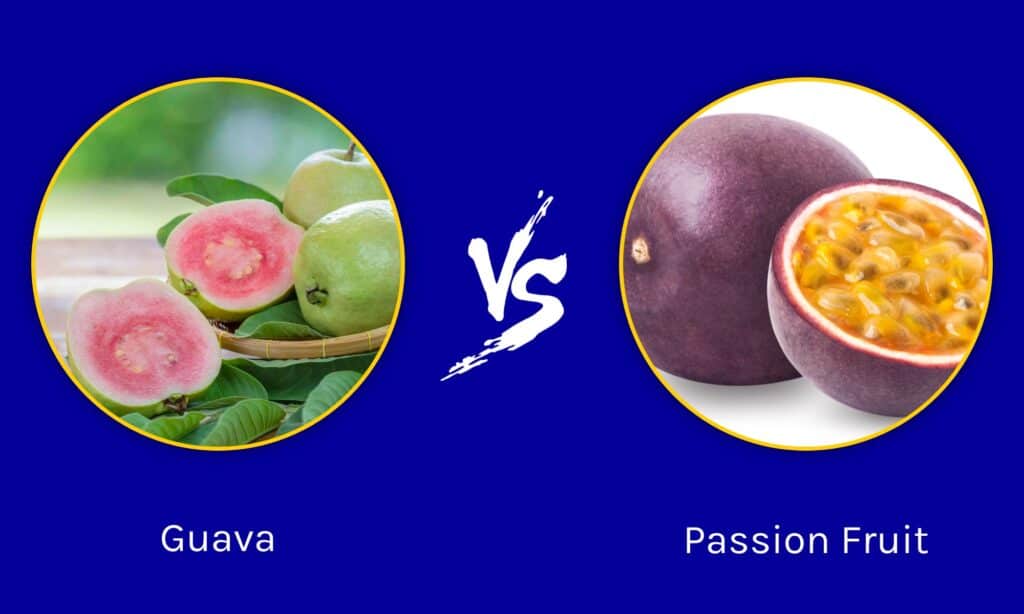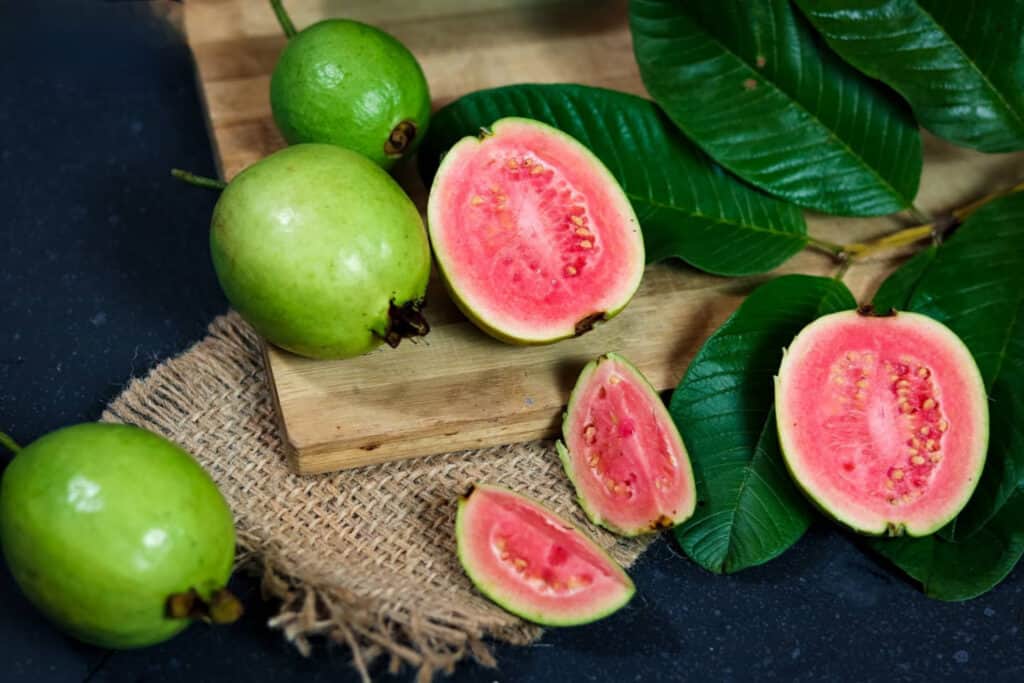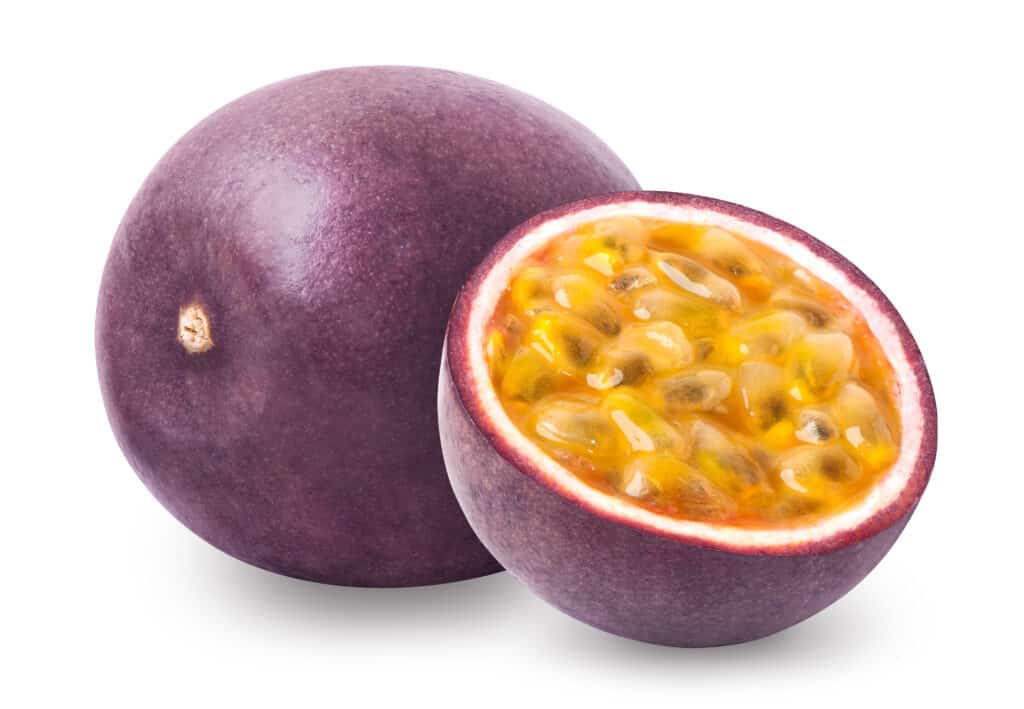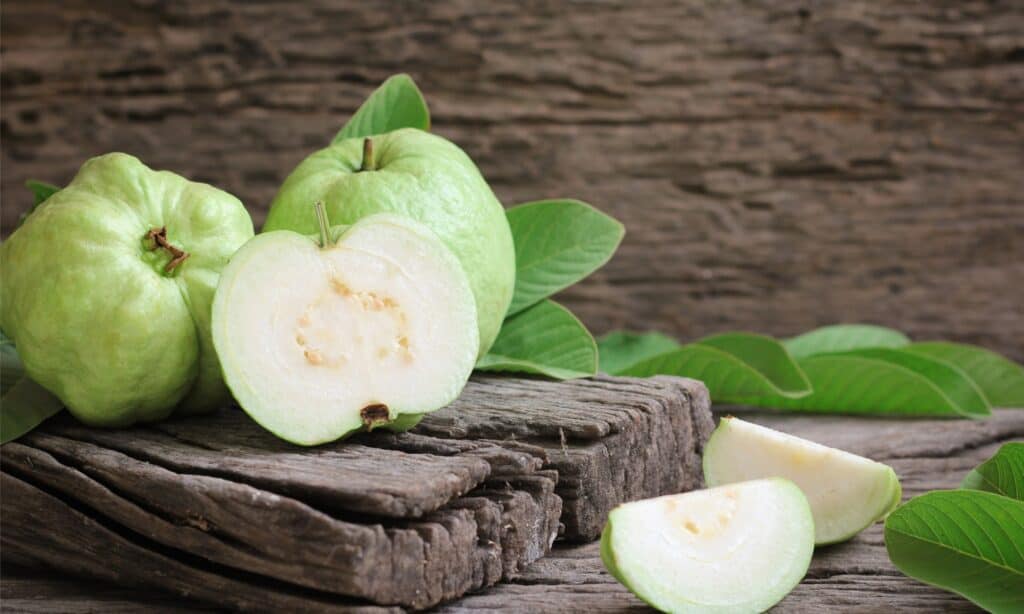Guavas and passion fruits are tropical fruits native to the Americas that are often used in juices, smoothies, and desserts. However, this doesn’t mean they are similar. Despite their similar uses, these two tropical fruits have different tastes and flavors. This article will share everything you need to know about guava vs. passion fruit, including their taste, plant type, origin, and use. We’re sure you’ll be an expert at distinguishing between the two by the end of the article!
Comparing Guava vs. Passion Fruit

| Guava | Passion Fruit | |
|---|---|---|
| Classification | Kingdom: Plantae Clade: Tracheophytes Clade: Angiosperms Clade: Eudicots Clade: Rosids Order: Myrtales Family: Myrtaceae Genus: Psidium Species: P. guajava | Kingdom: Plantae Clade: Tracheophytes Clade: Angiosperms Clade: Eudicots Clade: Rosids Order: Malpighiales Family: Passifloraceae Genus: Passiflora Species: P. edulis |
| Plant type | Fast-growing evergreen tropical tree or shrub | Vigorous, herbaceous, perennial, evergreen vining plant |
| Native to | Mexico, Central America, northern South America, and the Caribbean | South American continent, mostly Argentina, Brazil, Paraguay |
| Description | Shallow root system; an average height of 3 – 19 feet Slender trunk, 7.8 inches in diameter, with smooth, thin, greenish to red-brown barks Evergreen, oppositely arranged leaves, ovate-elliptic to oblong-elliptic leaf blades, 2 – 6 inches long; 1-2.7 inches wide; rounded or pointed tips, hairy and veined undersides; smooth upper sides White flowers, about 1.2 inches in diameter, growing alone or in 2-3 flower clusters at the leaf axils Rounded, oval, or pear-shaped fruit, 2-4 inches long and weighing up to 1.1 pounds; skin color is green to yellowish as it matures; the flesh is white, yellowish, or juicy pink or red with numerous yellowish and kidney-shaped seeds | Mature vine grows 10-15 feet high and 10 to 25 feet wide Stem with simple, axillary tendrils rolled up in spirals, 5.9 inches long Alternate, glossy dark green leaves with sawed edges up to 5 x 6 inches, more or less deeply 3-lobed, slightly leathery with 2 glands at the apex of the petiole Solitary flowers growing up to 2.8 inches in diameter Globose or oval to spherical yellow, greenish-yellow, or purplish fruits growing 1.6 – 2 inches wide and having multiple black/brown seeds surrounded by yellowish, orange, or greenish membranous sac |
| Cultivation | Soil type: thrives in loamy, sandy, and rocky soils pH range: 4.5 – 7 Climate conditions: cultivated in tropical and subtropical areas | Soil type: thrives in loamy and sandy soils pH range: 6.5 – 7.5 Climate: grows well in tropical, semitropical |
| USDA Hardiness Zone | Hardy in Zones 9-12 | Hardy in Zone 9-11 |
| Taste and Flavor | The pulp is sweet with a slightly tart aftertaste | Sweet but slightly acidic and musky |
| Uses | Cultivated for its edible fruit Used to control desertification, in the culinary world, as an ornamental tree; leaves used in traditional medicine | Cultivated for its edible fruit -Used as an ornamental tree in landscape design -Pulp used in making ice creams, sherbets, cocktails, and juices -Skin used as animals’ nutritional food |
The Key Differences Between Guava and Passion Fruit
As you’ve seen in the side-by-side comparison table above, guavas and passion fruits differ in many ways. The most obvious differences are their size, shape, and color. Now, let’s go over these dissimilarities in more detail so that you don’t miss a beat.
Guava vs. Passion Fruit: Classification

The guava is a tropical shrub or small tree classified as a species of the myrtle family (
Myrtaceae) of dicotyledonous plants.
©iStock.com/Abdul Sameer
Both guavas and passion fruits are found in tropical climates but differ in classification. The guava, scientifically named Psidium guajava, is a tropical shrub or small tree classified as a species of the myrtle family (Myrtaceae) of dicotyledonous plants. According to studies, there are about 100 different species of guava. The name guava is commercially associated with other species in the genus Psidium like Cattley guavas (Psidium littorale).
Here are other species of guava:
- Psidium friedrichsthalium – the Costa Rican guava
- Psidium guineense – Guinea guava
- Psidium montanum – Mountain guava
On the other hand, passion fruit is a vine species within a larger family of flowering plants, Passifloraceae. Passifloraceae is a large group consisting of about 750 species of plants classified in around 27 genera. Scientifically, passion fruits are called Passiflora edulis and belong to the genus Passiflora.
The common passion fruit varieties are:
- Purple passion fruit – Passiflora edulis f. edulis
- Yellow passion fruit – Passiflora edulis f. flavicarpa.
Guava vs. Passion Fruit: Origin and Distribution
Though the exact guava origin is uncertain, it is believed to have originated in an area extending from southern Mexico into or throughout Central America, northern South America, and the Caribbean Islands. According to archaeological sites in Peru, guava cultivation began in 2500 BCE. Today, guava is naturalized throughout the tropical and subtropical areas in Asia, tropical Africa, South Asia, and some parts of the United States. Guavas are also commercially grown in southwestern Europe and Greece.
Passion fruits originated from tropical America and southern Brazil through Paraguay and northern Argentina. The Aztecs had already cultivated passion fruits before their introduction to Europe by the Spanish missionaries. Today, passion fruit is intensely grown in the world’s tropical and semitropical regions, including Florida, Hawaii, Australia, Brazil, South Africa, Peru, Thailand, Indonesia, and Colombia. Passion fruits are also widely grown in North America, South America, and Kenya’s temperate climates.
Guava vs. Passion Fruit: Description

Passion fruit is ovoid to spherical in shape.
©Ekaterina Simonova/Shutterstock.com
While both guava and passion fruit plants produce colorful, edible fruits that are eaten raw, they can be distinguished by their height, leaves, flowers, and fruit type.
The guava is a fast-growing evergreen shrub or small tree reaching about 3 – 19 feet tall. The guava plant has a shallow root system and a slender trunk measuring 7.8 inches in diameter. The trunk is covered by thin, smooth greenish to red-brown barks that flake off, revealing greenish-brown layers beneath.
Guava branches are low drooping with evergreen, opposite, ovate-elliptic leaves, 2 – 6 inches long and 1 – 2.7 inches in diameter, pubescent and veined underneath, and glabrous on top. The plant produces 1.2-inch white flowers that grow singly or in 2 – 3 flower clusters at the upper leaf axils. Each flower has four or five green sepals, four or five petals, white stamens with yellow pollen, and is fragrant during the flowering season.
The guava fruit is rounded, ovoid, or pear-shaped and can weigh up to 1.1 pounds. The fruit skin is greenish and turns yellowish as it matures. Depending on the species, guava flesh exuding sour to sweet juice can either be white, yellow, pink, or red with yellowish seeds.
On the other hand, passion fruits are herbaceous, perennial, evergreen vining plants with grasping small green tendrils. A mature passion fruit vine can grow 10 – 15 feet tall. Passion fruit leaves are different from guava’s – they are more or less deeply 3-lobed and oblong with sawed edges and grow up to 6 inches long. The leaves grow in alternate patterns and are glossy dark green on the upper surface and pale green to matte underneath.
Another notable difference is that passion fruit vines have solitary fragrant flowers reaching 2 inches in diameter. The flowers have five white petals and a corona with filaments up to an inch long arranged in 4 – 5 rows. They have five stamens, white tips, and a purple base. The fruit is ovoid to spherical, 1.6 – 2 inches in diameter, and it becomes yellow, greenish-yellow, or dark purple when it matures.
Guava vs. Passion Fruit: Cultivation and Hardiness Zone
Typically, both guava and passion fruits thrive best in tropical and subtropical climates. However, passion fruit grows well in sandy and loamy soils, while guava thrives in loamy, rocky, and sandy soils.
Guavas grow best in the pH range of 4.5-7, whereas passion fruits are more commonly found in areas with a pH range of 6.5-7.5. The guava tree will take 2-3 years to reach maturity, while passion fruits usually take 12-18 months to produce fruit. When it comes to the hardiness zone, as per USDA, guavas grow best in hardy Zones 9 to 12, while passion fruits are hardy in Zones 9 to 11.
Guava vs. Passion Fruit: Uses

Guavas can be used in the culinary world as ingredients to make juices, ice creams, jams, sauces, desserts, and more.
©Smile Studio AP/Shutterstock.com
Guavas and passion fruits are used in multiple ways. They are both used in the culinary world as ingredients to make juices, ice creams, jams, sauces, desserts, and more. They also have many health benefits thanks to their medicinal properties. However, guavas can control desertification, whereas passion fruit plants cannot since they are not strong enough to act as windbreakers. Guava plants can also be used in handicrafts, in attracting pollinators, as insecticides, and as firewood. Dehydrated guava can be used to make guava powder. Additionally, guavas can be used as ornamental plants.
On the other side, passion fruit plants are known for their use as ornamental trees in landscaping. The fruit’s skin is used as animal food if dehydrated, thanks to its nutritional value.
Up Next:
The photo featured at the top of this post is © iStock.com/Murilo Gualda
Sources
- Food Struct, Available here: https://foodstruct.com/compare/passion-fruit-vs-guava
- Guava Facts, Available here: https://www.guavafacts.com/guava-vs-passion-fruit/
- Compare Fruits, Available here: https://fruits.nutriarena.com/en/guava-vs-passionfruit-characteristics/comparison-19-52-6
- Fruits & Vegetables, Available here: https://www.frutas-hortalizas.com/Fruits/About-Passion-fruit.html
Thank you for reading! Have some feedback for us? Contact the AZ Animals editorial team.






